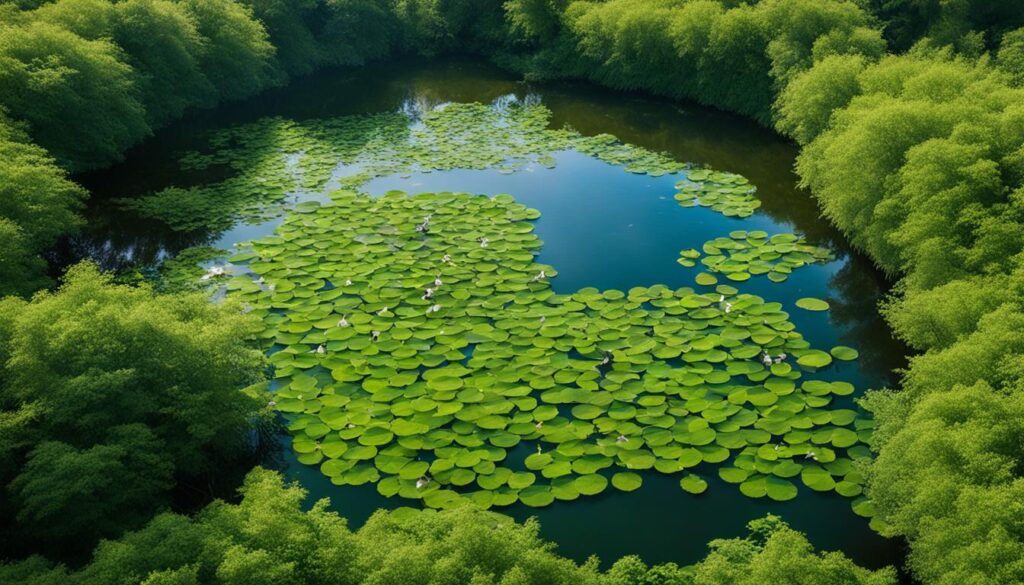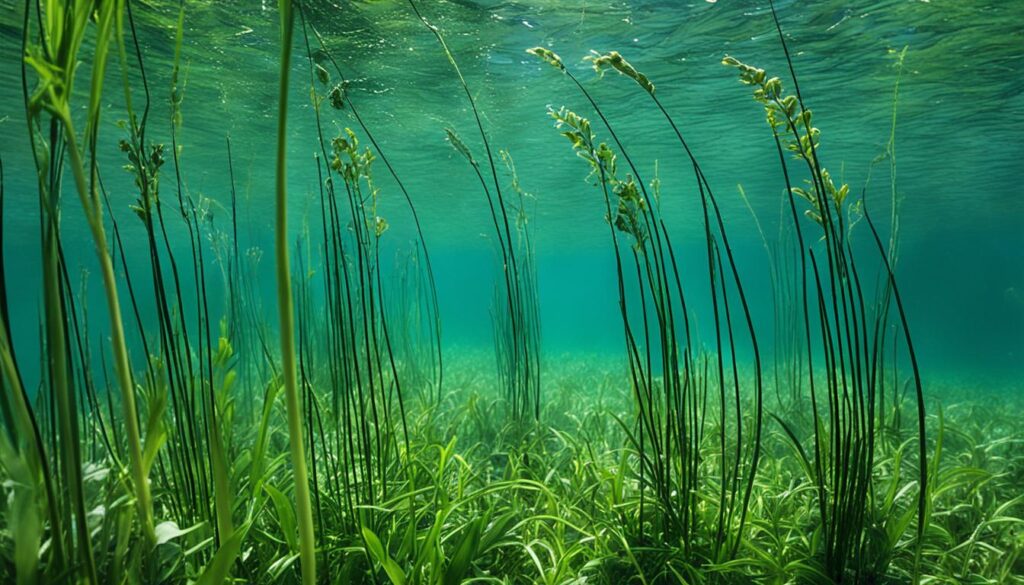In this comprehensive guide, I will introduce you to the mesmerizing Duck Potato Florida Aquatic Plant. Native to the wetlands of Florida, this remarkable plant not only adds a unique beauty to its surroundings but also plays a vital role in the state’s ecosystem. Join me as we explore its characteristics, benefits, and how to identify it among other Florida native plants.
Submerged Aquatic Plants in Florida
Before we dive into the fascinating world of Duck Potato, it’s important to understand the broader category it belongs to – submerged aquatic plants. These native plants are abundantly found in the wetlands of Florida and have evolved to thrive in the state’s unique aquatic environments.
Submerged aquatic plants play a crucial role in maintaining the health and balance of Florida’s water ecosystems. They provide habitat, food, and shelter for a wide range of aquatic species, contributing to the overall biodiversity of the region.
Florida’s lakes, rivers, and marshes are home to a diverse array of submerged aquatic plant species. Each species has its own distinctive characteristics and adapts to different water depths, temperatures, and nutrient levels.
Types of Submerged Aquatic Plants in Florida
- Kaw – Also known as Coontail, Kaw is a common submerged aquatic plant in Florida’s freshwater systems. It is recognizable by its feathery, dark-green leaves and forms dense underwater canopies.
- Tape Grass – This species, called Eelgrass or Vallisneria, features long, ribbon-like leaves that sway with the water currents. Tape Grass is an important food source for manatees and serves as a nursery for many fish species.
- Hydrilla—Hydrilla is an invasive submerged aquatic plant that poses significant challenges to Florida’s aquatic ecosystems. It spreads rapidly and can outcompete native species, leading to ecological imbalances.
These examples represent just a fraction of the submerged aquatic plant species in Florida’s water bodies. Each plant contributes to the overall health and vitality of the state’s aquatic environments, playing a crucial role in oxygen production, nutrient cycling, and water filtration.
As we continue our exploration of Florida’s native plants, stay tuned for the next section, where we will dive deeper into the world of Duck Potato. Get ready to discover the captivating characteristics and benefits of this unique Florida aquatic plant.
Identifying Duck Potato in Florida Wetlands
Now that we have a foundation on submerged aquatic plants, let’s focus on the star of our guide – the Duck Potato Florida Aquatic Plant. This section will provide you with valuable insights into how to identify this beautiful plant in Florida’s wetlands. From its unique foliage to its distinctive flowers and growth patterns, we will equip you with the knowledge to spot the Duck Potato confidently.
Characteristics of Duck Potato
The Duck Potato, scientifically known as Sagittaria latifolia, is a perennial wetland plant native to Florida. It is commonly found in freshwater marshes, ponds, and lakes, where it thrives in shallow water or muddy areas.
This aquatic plant features broad, arrowhead-shaped leaves that can grow up to a foot long. The leaves are smooth and typically have a dark green color. They are arranged in clusters along long, slender stems that rise above the water’s surface.
One of the distinguishing features of the Duck Potato is its beautiful white flowers. These flowers bloom from spring to early fall and grow on tall stalks above the foliage. Each flower has three petals and a yellow center, creating an eye-catching display.
Identifying Duck Potato
When trying to identify Duck Potato in Florida’s wetlands, there are a few key characteristics to look out for:
- Leaf Shape: The duck potato’s broad, arrowhead-shaped leaves are a prominent feature. Look for triangular leaves with rounded or pointed tips.
- Leaf Color: The leaves of Duck Potato have a dark green color, which helps them blend in with the surrounding vegetation.
- Leaf Arrangement: The leaves grow in clusters along long stalks that rise above the water’s surface. This growth pattern is a distinguishing factor.
- Flower Appearance: The Duck Potato produces beautiful white flowers with three petals and a yellow center. These flowers are an excellent indicator of the plant’s presence.
Where to Find Duck Potato
Florida’s wetlands are the ideal habitat for Duck Potato. Look for this aquatic plant in freshwater marshes, ponds, lakes, and other shallow water bodies. It thrives in areas with ample sunlight and moist soil.
When exploring wetlands and searching for Duck Potato, keep an eye out for areas with standing water or muddy patches. These are the ideal conditions for this plant to grow. You may also find other native wetland plants alongside Duck Potato, further enhancing the natural beauty of Florida’s wetlands.
Benefits and Management of Duck Potato
The Duck Potato Florida Aquatic Plant is not only a visually appealing plant but also plays a vital role in Florida’s wetlands. This native Florida plant offers numerous benefits to the ecosystem, making it a valuable component of aquatic vegetation management.
Ecological Functions
One of the key benefits of the Duck Potato is its role in soil stabilization. The dense network of roots helps to anchor the plant, preventing soil erosion in wetland areas. This stabilization is crucial for maintaining the integrity of the surrounding landscape.
In addition to soil stabilization, the Duck Potato contributes to erosion control. The extensive root system acts as a natural barrier, minimizing the impact of water movement and reducing the risk of erosion. This is especially important in highly vulnerable areas prone to high tides or strong currents.
Furthermore, the Duck Potato provides essential habitat for various wildlife species. Its floating leaves and dense vegetation offer shelter and breeding grounds for aquatic animals, including fish, turtles, and birds. This makes the plant a vital component of the wetland ecosystem, supporting biodiversity and promoting healthy populations of native Florida plants and animals.
Management Practices
To effectively manage Duck Potato and maintain a healthy aquatic environment, certain practices should be followed. It’s essential to strike a balance between the plant’s ecological benefits and the need to control its growth in sensitive areas.
“Proper management of Duck Potato involves maintaining optimal water levels and controlling excessive vegetative growth. Using native Florida plants in wetland restoration projects can also help maintain a healthy balance and support the overall ecosystem.”
When implementing vegetation management strategies, it’s crucial to consider the potential impact on other native plant species and wildlife. Sustainable and environmentally-friendly approaches, such as manual removal and controlled herbicide application, should be employed to minimize negative consequences.
By adopting responsible management practices, we can ensure the long-term viability of Duck Potato populations while preserving the ecological integrity of Florida’s wetlands.
Summary
The Duck Potato Florida Aquatic Plant significantly benefits the state’s wetland ecosystems. With its role in soil stabilization, erosion control, and wildlife habitat provision, this native Florida plant plays a crucial part in aquatic vegetation management. By carefully managing its growth and prioritizing the conservation of other native plant species, we can promote a healthy and thriving wetland environment for generations.

| Benefits | Management Practices |
|---|---|
| 1. Soil stabilization | 1. Maintain optimal water levels |
| 2. Erosion control | 2. Control excessive vegetative growth |
| 3. Wildlife habitat | 3. Consider native plant species in wetland restoration |
| 4. Use sustainable management practices |
Conclusion
In conclusion, the Duck Potato Florida Aquatic Plant is a gem of Florida’s wetlands. Its unique beauty, ecological significance, and adaptability make it a valuable addition to any natural water habitat. As a native plant species in Florida, the Duck Potato contributes to the state’s rich biodiversity and plays a crucial role in maintaining the health of wetland ecosystems.
By understanding the characteristics and identifying features of the Duck Potato, we can appreciate its importance and work towards its preservation. Proper management practices, such as controlling its growth and protecting its habitat, are essential for ensuring the survival of this magnificent plant.
Exploring the world of Duck Potato allows us to marvel at the wonders of Florida’s diverse plant life. Whether you are a nature enthusiast, an avid photographer, or simply curious about the native flora, encountering this stunning plant is a memorable experience. So, please take the opportunity to immerse yourself in the beauty of the Duck Potato Florida Aquatic Plant and witness the magic it brings to Florida’s wetlands.
FAQ
What is the Duck Potato Florida Aquatic Plant?
The Duck Potato Florida Aquatic Plant, also known as Sagittaria lancifolia, is a native plant species found in the wetlands of Florida. It is known for its unique beauty and significant ecological role in the state’s ecosystem.
What are some other native plant species in Florida?
Florida is home to a wide variety of native plants. Some other native plant species in Florida include Sawgrass, Pickerelweed, Water Lily, and Cypress Trees.
How do I identify the Duck Potato among other Florida native plants?
The Duck Potato can be identified by its lance-shaped leaves, distinctive white flowers, and tuber-like structures found underground. It usually grows in wetland areas, such as marshes, swamps, and the edges of lakes or rivers.
What benefits does the Duck Potato provide in Florida’s wetlands?
The Duck Potato plays a crucial role in Florida’s wetland ecosystems. It helps stabilize the soil, control erosion, and provide habitat for various wildlife species. Its dense growth also assists in reducing nutrient loading in the water.
How can I manage Duck Potato and ensure a healthy aquatic environment?
Proper aquatic vegetation management techniques, such as controlled herbicide application and mechanical removal, can help manage Duck Potato populations effectively. It is important to consult with experts and follow local regulations for responsible management.
